Multi-Stage Optimal Power Control Method for Distribution Network with Photovoltaic and Energy Storage Considering Grouping Cooperation
Abstract
:1. Introduction
- (1)
- Taking a radial distribution network as an example, the mechanism by which the optical-storage system influences the voltage is explored, which lays a theoretical foundation for subsequent research.
- (2)
- In order to clarify the priority of each resource and comprehensively consider the regulation cost and voltage power sensitivity, a comprehensive voltage–cost sensitivity index is proposed (the resource with the highest traditional sensitivity may have a high cost, the resource with a low cost may have high sensitivity, and only the resource with high voltage–cost sensitivity has the lowest cost), which is used as a benchmark for regulation to ensure the lowest regulation cost.
- (3)
- We avoid reverse regulation as much as possible (for example, if the sensitivity of over-voltage node A1 and control node C is positive, and the sensitivity of over-voltage node A2 and control node C is negative, the power of node C is reduced when the voltage of node A1 is reduced, but the power of node C is increased when the voltage of node A2 is reduced). The power of energy storage and the power of the photovoltaic inverter are divided into four groups according to the overall voltage–cost sensitivity. A grouping cooperative control strategy is proposed, giving priority to the resources with higher voltage–cost sensitivity.
2. Mechanisms of the Impact of PV and ES Systems on Distribution Network Voltage
2.1. Without Photovoltaic and Energy Storage
2.2. Discharge of Photovoltaic-Storage System during Peak Period
2.3. Charge of Photovoltaic-Storage System during Valley Period
2.4. Feasibility Analysis of Cooperative Control of Photovoltaic Storage
3. Voltage–Cost Sensitivity Calculation Method
3.1. Adjustment Cost Model of Photovoltaic-Storage System
3.1.1. Unit Regulation Cost Model of Energy Storage
3.1.2. Unit Regulation Cost Model of PV
3.2. Voltage–Cost-Based Sensitivity
4. Multi-Stage Voltage Overrun Control Based on Group Collaboration
4.1. A Grouping Method Based on Voltage–Cost Sensitivity
4.2. Multi-Stage Over-Voltage Control Based on Group Collaboration
4.2.1. Over-Voltage Control Method in the First Stage
- (1)
- Determination of optimal voltage curve
- (2)
- Over-voltage control model
4.2.2. Over-Voltage Control Method in the Second Stage
4.2.3. Over-Voltage Control Method in the Third Stage
5. Simulation Analysis
5.1. Example Introduction
5.2. Simulation Results of the Method in This Paper
- (1)
- There are three peaks in the over-voltage process. The first peak voltage is small, and only node 18 voltage is out of limit. At this time, the inverters of nodes 10, 16, and 18 are involved in voltage regulation. The output power value increases with the reduction in the impedance distance from the over-voltage node, and node 18 is not working at full load because it is a local node. At the same time, the inverters of other nodes did not act because of the low voltage sensitivity and the high unit voltage regulation cost.
- (2)
- At the second voltage peak, the voltage exceeds the limit more, and the inverters of nodes 10, 16, and 18 inject a large amount of reactive power into the distribution network. During this period, there is short-term saturation, and node 10 also has a greater sensitivity. At the same time, the inverter of node 33 also participates in voltage regulation in the period, but the two over-voltage values did not exceed 0.015 p.u., so the energy storage of all nodes except node 18 was not put into voltage regulation.
- (3)
- The third over-voltage value is much higher than the previous two over-voltage values. The inverter of node 25 is also put into use, and the energy storage of other nodes that have not been put into use before also participate in voltage regulation. Node 18 is the dominant node, and node 16 is close to the dominant node and has large capacity, so the energy storage of these two nodes has high output power. The output power of nodes 10 and 33 far away from the dominant node is relatively small because of their small voltage sensitivity and higher unit voltage regulation cost under the same voltage regulation effect.
5.3. Comparative Analysis with Traditional Methods
5.4. Simulation Analysis of Real Power Grid
6. Conclusions
- (1)
- The voltage control in this paper gives priority to the use of resources with high voltage sensitivity for voltage control. This index considers the unit regulation cost and power sensitivity of the regulation resources at the same time, and can achieve the best voltage control effect with the minimum regulation cost.
- (2)
- Compared with the traditional decentralized control strategy and two-phase control strategy, the least resources are called for and the lowest regulation cost is achieved without voltage overrun.
Author Contributions
Funding
Data Availability Statement
Conflicts of Interest
References
- Chunguang, Y.; Xue, W.; Qichao, S.; Wu, H.; Zhu, Y. An Enhanced Power Allocation Strategy for Microgrids Considering Frequency and Voltage Restoration. Electronics 2024, 13, 1966. [Google Scholar] [CrossRef]
- Guo, Y.; Gao, H.; Wang, D.; Wu, Q. Online Optimal Feedback Voltage Control of Wind Farms: Decentralized and Asynchronous Implementations. IEEE Trans. Sustain. Energy 2021, 12, 1489–1492. [Google Scholar] [CrossRef]
- Zhang, Y.; Qian, W.; Shao, J.; Zhang, F.; Wang, L.; Hu, Q.; Li, W. Adaptive Voltage Reference Based Controls of Converter Power Sharing and Pilot Voltage in HVDC System for Large-Scale Offshore Wind Integration. IEEE Open Access J. Power Energy 2024, 11, 55–67. [Google Scholar] [CrossRef]
- Akekachai, P.; Tanakorn, K.; Chayakarn, S.; Pachapan, P.; Hinkkannen, M.; Somkun, S. Design and Implementation of Single-Phase Grid-Connected Low-Voltage Battery Inverter for Residential Applications. Electronics 2024, 13, 1014. [Google Scholar] [CrossRef]
- Maharjan, S.; Khambadkone, A.M.; Peng, J.C.-H. Robust Constrained Model Predictive Voltage Control in Active Distribution Networks. IEEE Trans. Sustain. Energy 2021, 12, 400–411. [Google Scholar] [CrossRef]
- Cheng, Z.; Wang, L.; Zeng, S.; Su, C.; Zhang, R.; Zhou, W. Partition-Global Dual-Layer Collaborative Voltage Control Strategy for Active Distribution Network With High Proportion of Renewable Energy. IEEE Access 2024, 12, 22546–22556. [Google Scholar] [CrossRef]
- Kou, P.; Liang, D.; Gao, R.; Liu, Y.; Gao, L. Decentralized Model Predictive Control of Hybrid Distribution Transformers for Voltage Regulation in Active Distribution Networks. IEEE Trans. Sustain. Energy 2020, 11, 2189–2200. [Google Scholar] [CrossRef]
- Liu, Q.; Wang, Y.; Wang, S.; Liang, D.; Zhao, Q.; Zhao, X. Voltage Regulation Strategy for DC Distribution Networks Based on Coordination of Centralized Control and Adaptive Droop Control. IEEE Trans. Power Deliv. 2022, 37, 3730–3739. [Google Scholar] [CrossRef]
- Gui, Y.; Nainar, K.; Bendtsen, J.D.; Diewald, N.; Iov, F.; Yang, Y.; Blaabjerg, F.; Xue, Y.; Liu, J.; Hong, T.; et al. Voltage Support With PV Inverters in Low-Voltage Distribution Networks: An Overview. IEEE J. Emerg. Sel. Top. Power Electron. 2024, 12, 1503–1522. [Google Scholar] [CrossRef]
- Zhang, B.; Tang, W.; Liang, J.; Zhang, L.; Zhao, C. EV Integration-Oriented DC Conversion of AC Low-Voltage Distribution Networks and the Associated Adaptive Control Strategy. IEEE Trans. Transp. Electrif. 2024, 10, 213–223. [Google Scholar] [CrossRef]
- Gerdroodbari, Y.Z.; Razzaghi, R.; Shahnia, F. Decentralized Control Strategy to Improve Fairness in Active Power Curtailment of PV Inverters in Low-Voltage Distribution Networks. IEEE Trans. Sustain. Energy 2021, 12, 2282–2292. [Google Scholar] [CrossRef]
- Kriukov, A.; Gavrilaş, M.; Ivanov, O.; Grigoraş, G.; Neagu, B.-C.; Scarlatache, F. Novel Decentralized Voltage-Centered EV Charging Control Algorithm Using DSRC System in Low Voltage Distribution Networks. IEEE Access 2021, 9, 164779–164800. [Google Scholar] [CrossRef]
- Alzaareer, K.; Saad, M.; Mehrjerdi, H.; Asber, D.; Lefebvre, S. Development of New Identification Method for Global Group of Controls for Online Coordinated Voltage Control in Active Distribution Networks. IEEE Trans. Smart Grid 2020, 11, 3921–3931. [Google Scholar] [CrossRef]
- Wang, Y.; Syed, M.H.; Guillo-Sansano, E.; Xu, Y.; Burt, G.M. Inverter-Based Voltage Control of Distribution Networks: A Three-Level Coordinated Method and Power Hardware-in-the-Loop Validation. IEEE Trans. Sustain. Energy 2019, 11, 2380–2391. [Google Scholar] [CrossRef]
- Nguyen, H.M.; Torres, J.L.R.; Lekić, A.; Pham, H.V. MPC Based Centralized Voltage and Reactive Power Control for Active Distribution Networks. IEEE Trans. Energy Convers. 2021, 36, 1537–1547. [Google Scholar] [CrossRef]
- Mudaliyar, S.; Mishra, S. Real-Time Coordinated Control of Low-Voltage DC Distribution Network With Soft Opening Point. IEEE Trans. Power Electron. 2021, 36, 7123–7137. [Google Scholar] [CrossRef]
- Xu, X.; Li, Y.; Yan, Z.; Ma, H.; Shahidehpour, M. Hierarchical Central-Local Inverter-Based Voltage Control in Distribution Networks Considering Stochastic PV Power Admissible Range. IEEE Trans. Smart Grid 2023, 14, 1868–1879. [Google Scholar] [CrossRef]
- Su, T.; Zhao, J.; Pei, Y.; Ding, F. Probabilistic Physics-Informed Graph Convolutional Network for Active Distribution System Voltage Prediction. IEEE Trans. Power Syst. 2023, 38, 5969–5972. [Google Scholar] [CrossRef]
- Huo, Y.; Li, P.; Ji, H.; Yu, H.; Yan, J.; Wu, J.; Wang, C. Data-Driven Coordinated Voltage Control Method of Distribution Networks with High DG Penetration. IEEE Trans. Power Syst. 2023, 38, 1543–1557. [Google Scholar] [CrossRef]
- Li, Y.; Lu, C.; Tang, Y.; Fang, C.; Cui, Y. Dynamic Control and Time-Delayed Channel Scheduling Co-Design for Voltage Control in Active Distribution Networks. IEEE Trans. Smart Grid 2024, 15, 1837–1848. [Google Scholar] [CrossRef]
- Dutta, A.; Ganguly, S.; Kumar, C. Coordinated Volt/Var Control of PV and EV Interfaced Active Distribution Networks Based on Dual-Stage Model Predictive Control. IEEE Syst. J. 2022, 16, 4291–4300. [Google Scholar] [CrossRef]
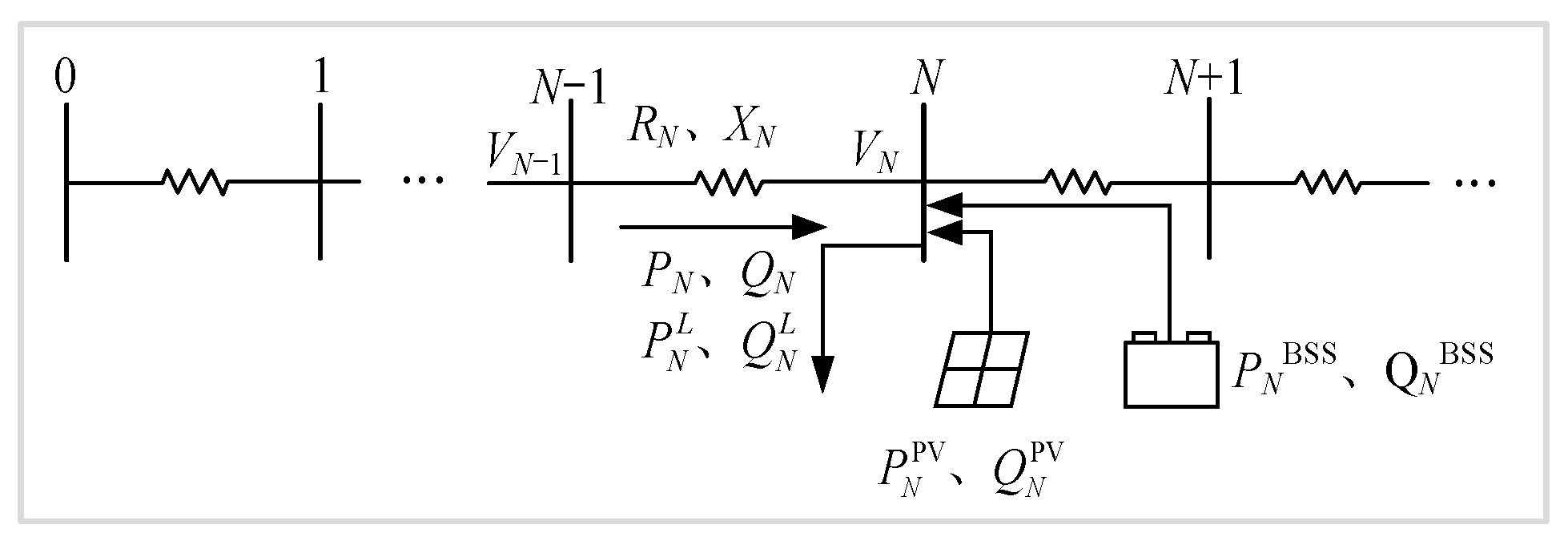


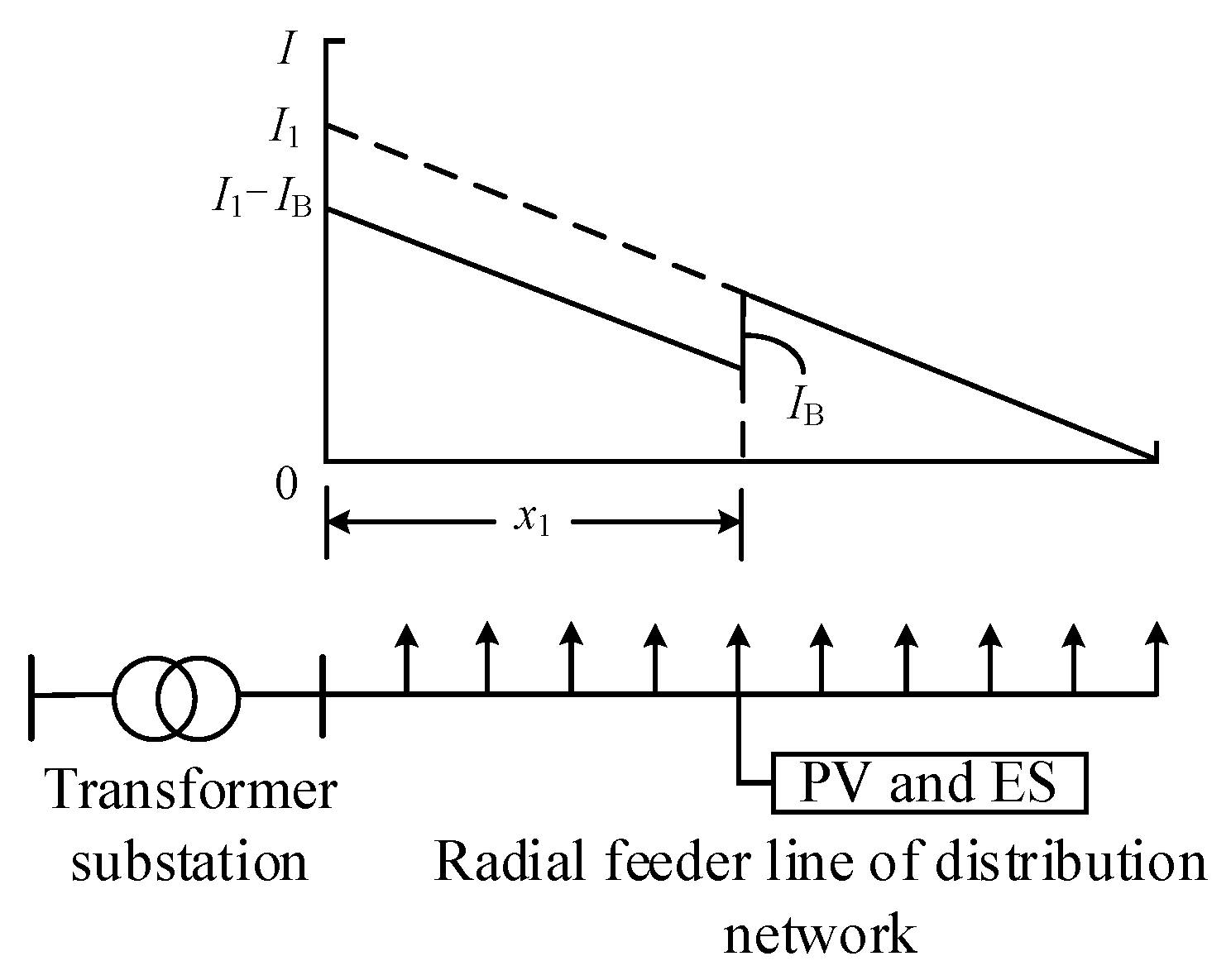



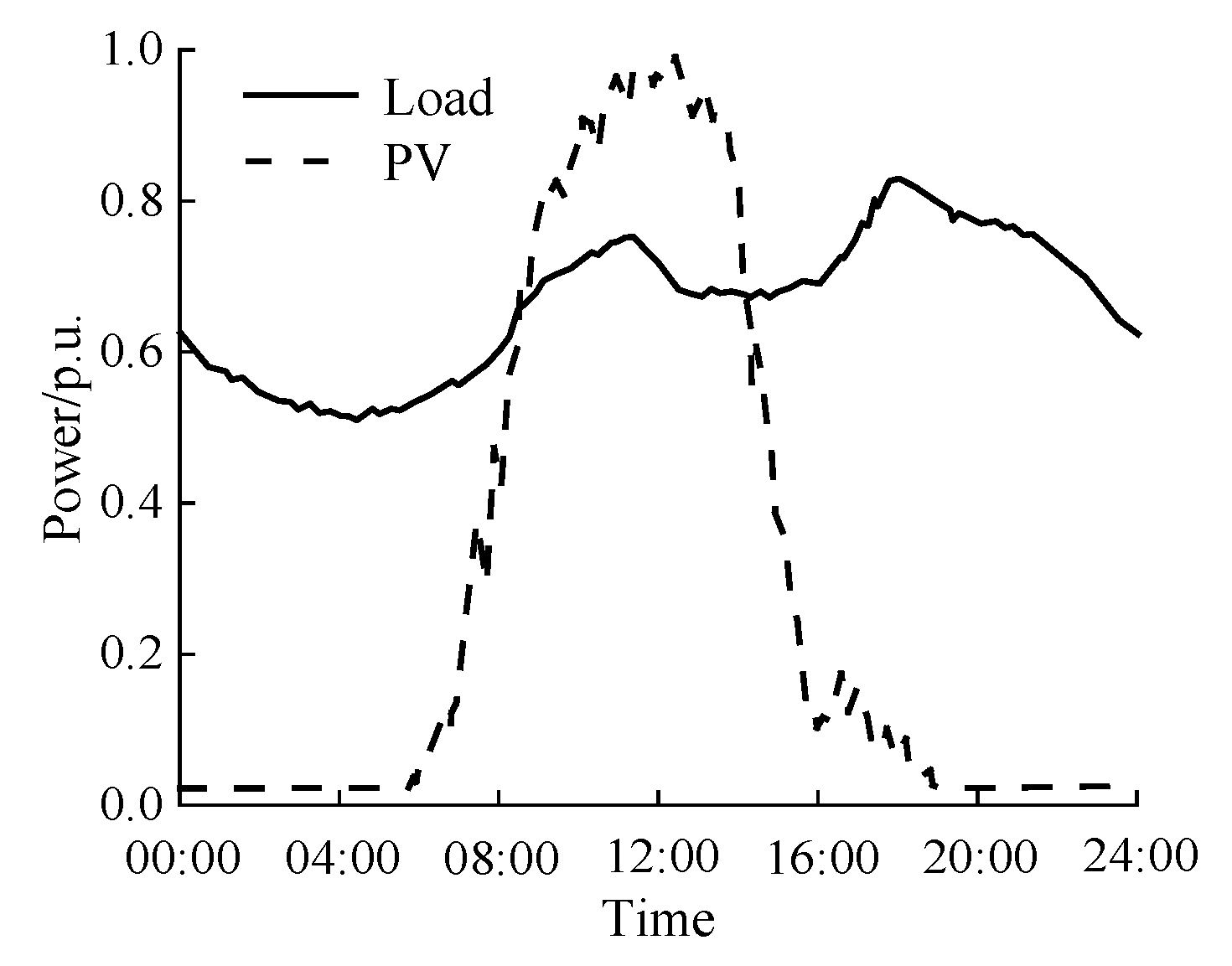
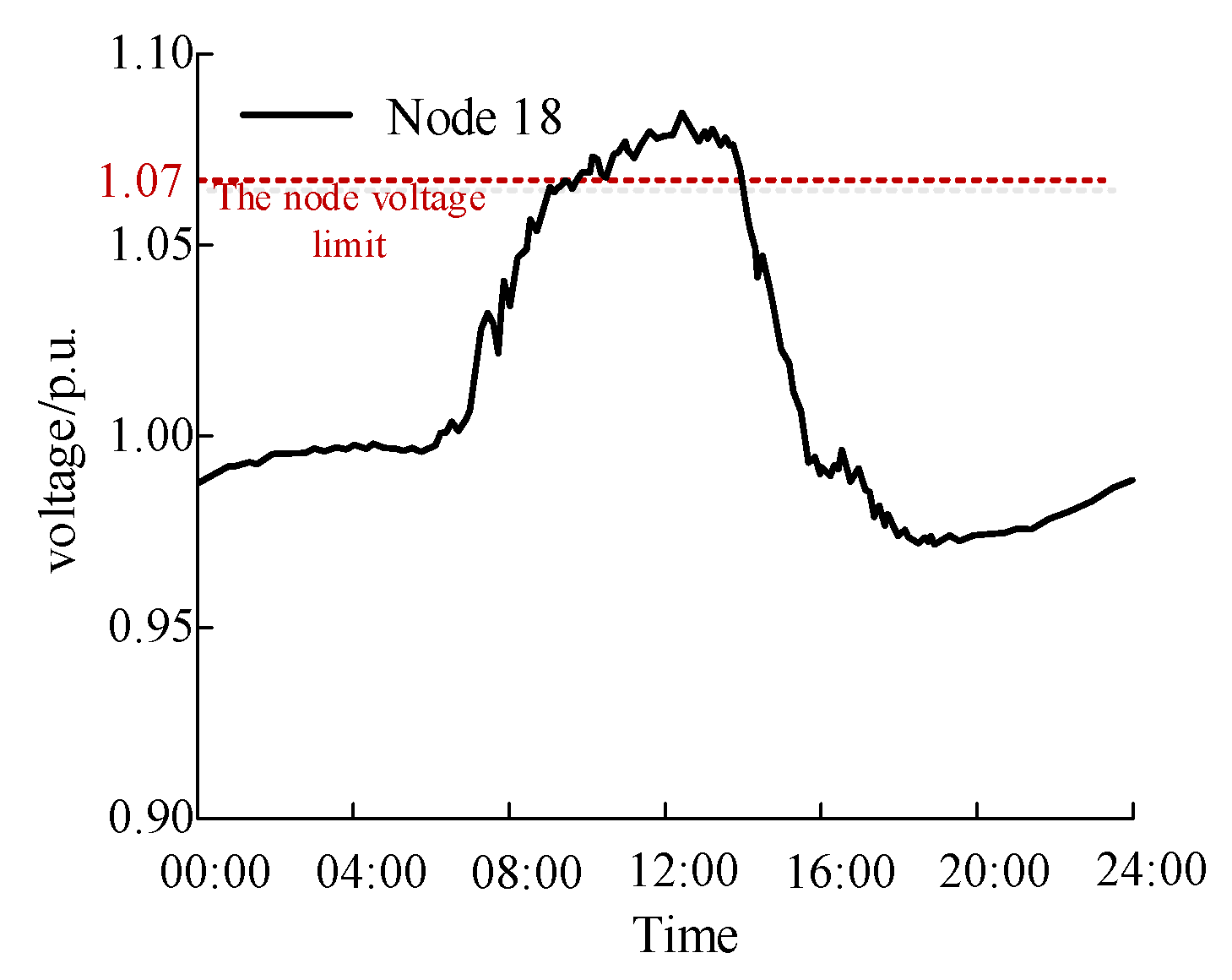

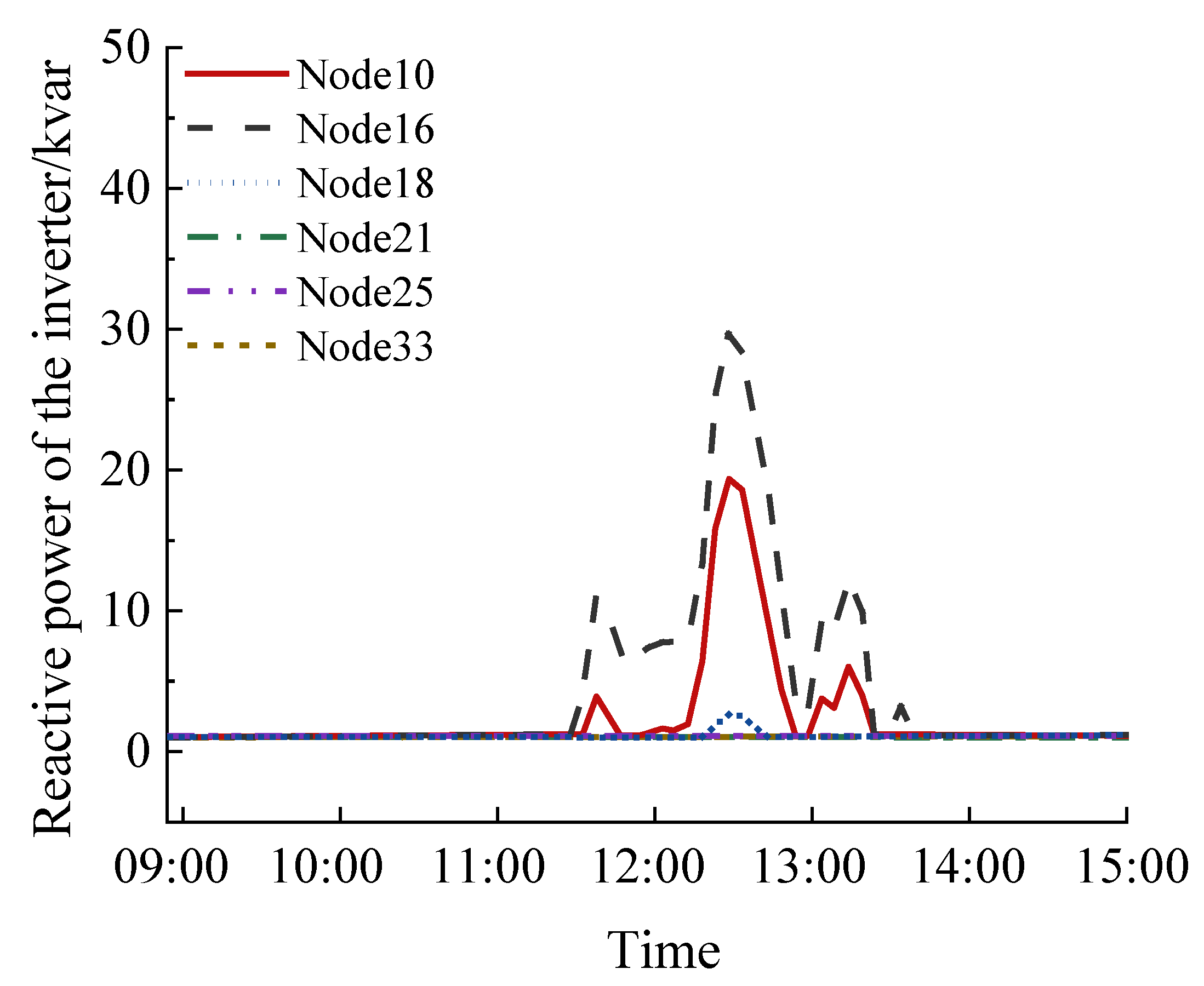
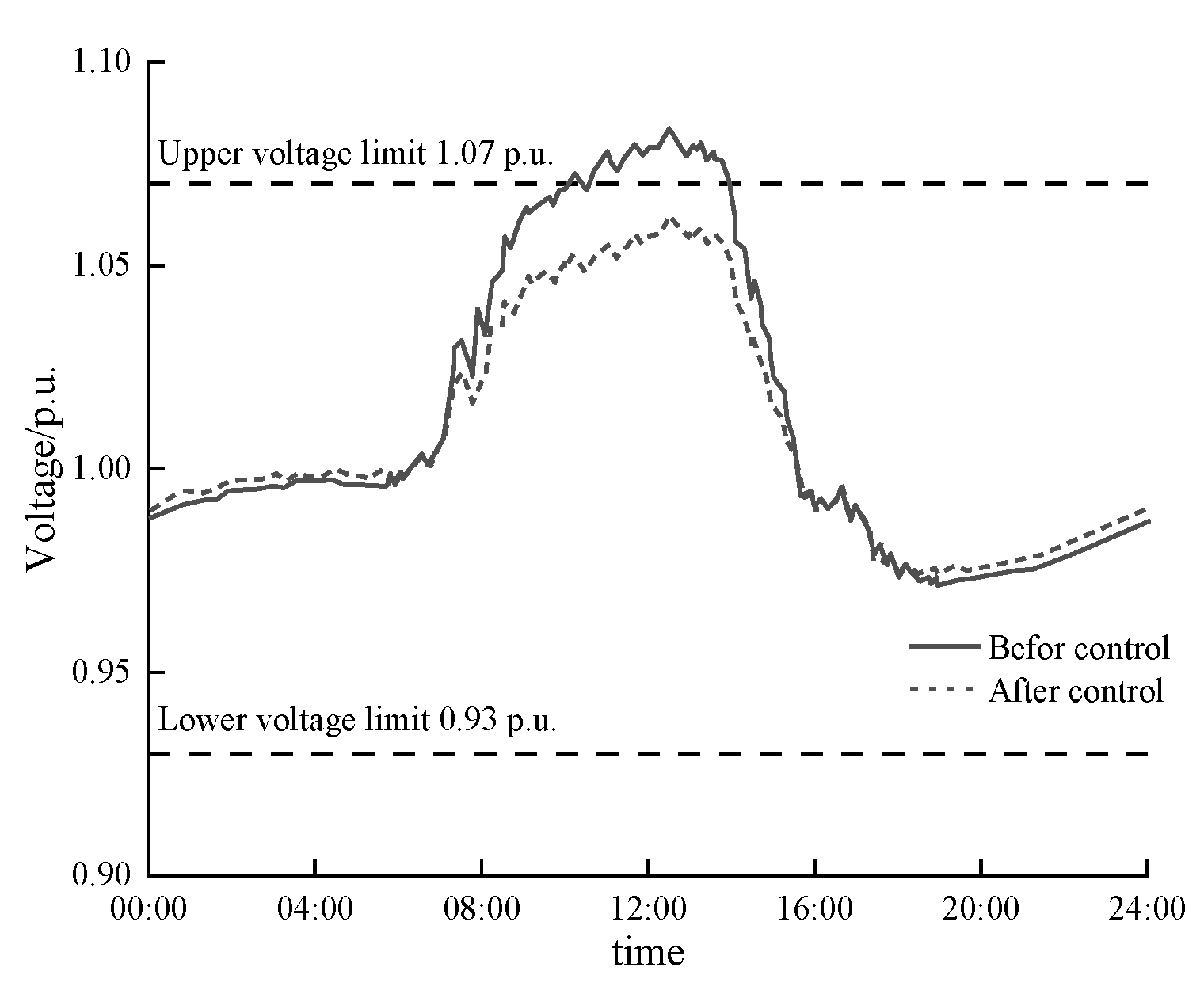
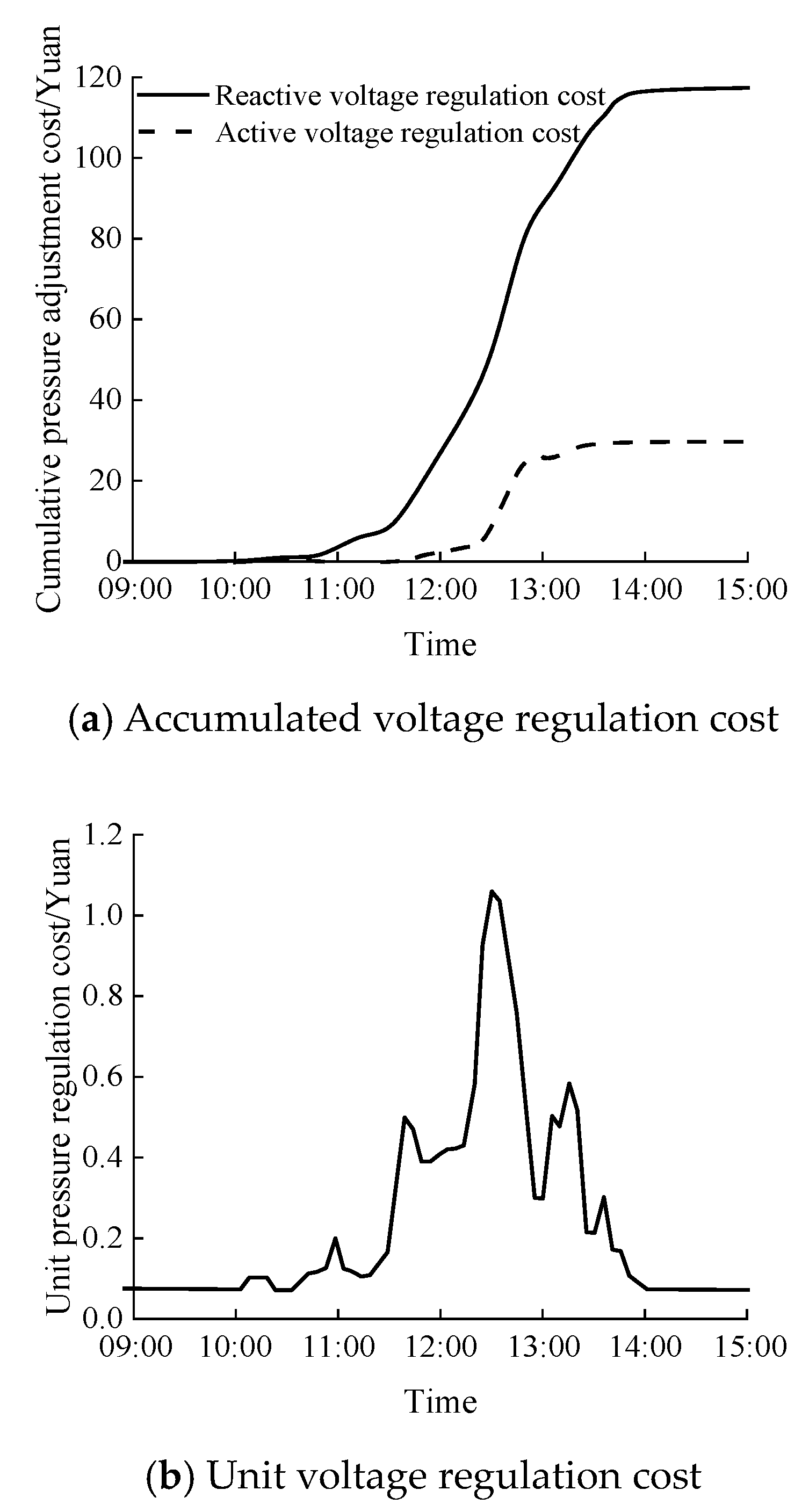



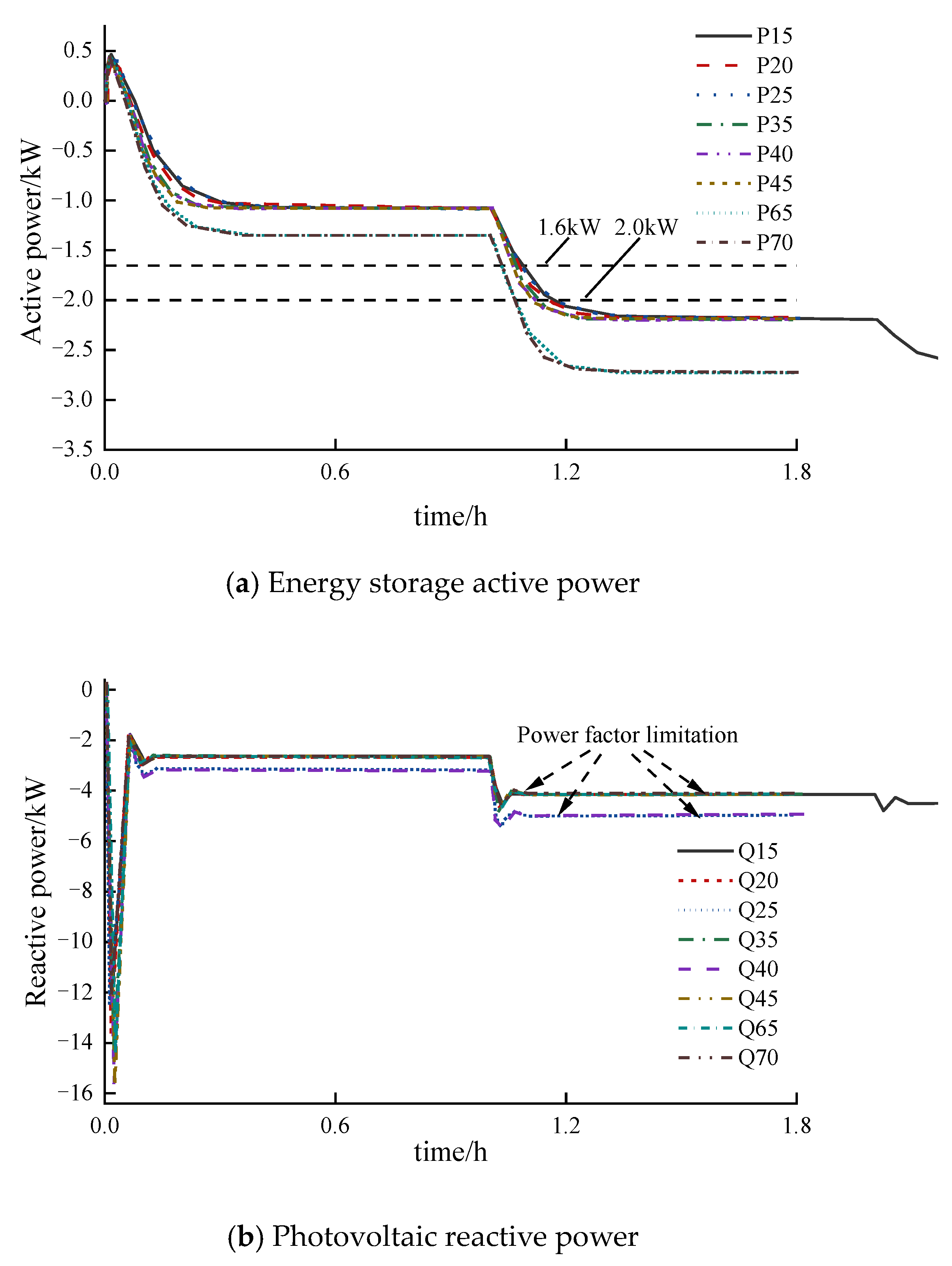

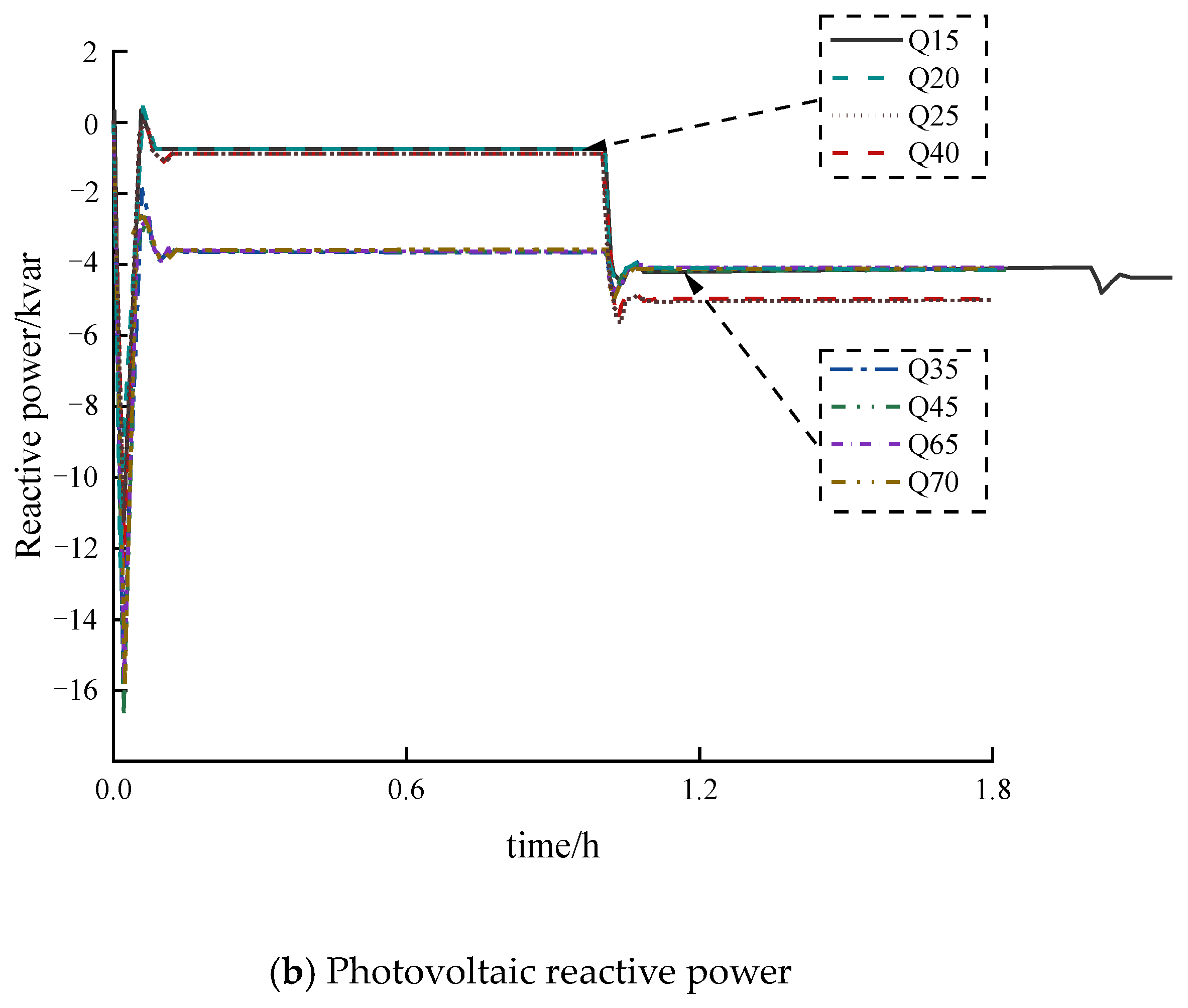

| Scene | Conditions | Voltage Loss Trends | ||
|---|---|---|---|---|
| Peak period | / | Down | ||
| Rising | ||||
| Down | ||||
| / | Down | |||
| Rising | ||||
| Down | ||||
| / | Rising | |||
| valley period | / | Down | ||
| Rising | ||||
| Down | ||||
| / | Down | |||
| Rising | ||||
| Down | ||||
| / | Rising | |||
| Voltage Overrun Type | Control Nodes | |
|---|---|---|
| Positive Sensitivity | Negative Sensitivity | |
| Voltage exceeds the upper limit | Downward adjustments | Upward adjustments |
| Voltage exceeds the lower limit | Upward adjustments | Downward adjustments |
| Node Number | Maximum Voltage | Node Number | Maximum Voltage |
|---|---|---|---|
| Node 18 | 1.098 | Node 15 | 1.077 |
| Node 33 | 1.073 | Node 16 | 1.082 |
| Node 13 | 1.070 | Node 17 | 1.091 |
| Node 14 | 1.073 | Node 25 | 1.074 |
| Grouping | Resource Number | Adjustable Capacity | Grouping | Resource Number | Adjustable Capacity | ||||
|---|---|---|---|---|---|---|---|---|---|
| B | Node 18 | Energy storage active power | 30 | 0.7721 | C | Node 20 | Energy storage active power | 0 | 0 |
| Photovoltaic reactive power | 25 | 0.8573 | Photovoltaic reactive power | 30 | 0.2954 | ||||
| B | Node 16 | Energy storage active power | 0 | 0 | C | Node 24 | Energy storage active power | 0 | 0 |
| Photovoltaic reactive power | 40 | 0.7435 | Photovoltaic reactive power | 10 | 0.2877 | ||||
| B | Node 10 | Energy storage active power | 20 | 0.7006 | C | Node 17 | Energy storage active power | 0 | 0 |
| Photovoltaic reactive power | 40 | 0.7106 | Photovoltaic reactive power | 35 | 0.2567 | ||||
| B | Node 33 | Energy storage active power | 10 | 0.6854 | C | Node 31 | Energy storage active power | 0 | 0 |
| Photovoltaic reactive power | 20 | 0.6908 | Photovoltaic reactive power | 38 | 0.2139 | ||||
| C | Node 25 | Energy storage active power | 0 | 0 | C | Node 32 | Energy storage active power | 0 | 0 |
| Photovoltaic reactive power | 40 | 0.3544 | Photovoltaic reactive power | 55 | 0.2091 | ||||
| C | Node 21 | Energy storage active power | 0 | 0 | C | Node 28 | Energy storage active power | 0 | 0 |
| Photovoltaic reactive power | 30 | 0.3106 | Photovoltaic reactive power | 50 | 0.1583 | ||||
Disclaimer/Publisher’s Note: The statements, opinions and data contained in all publications are solely those of the individual author(s) and contributor(s) and not of MDPI and/or the editor(s). MDPI and/or the editor(s) disclaim responsibility for any injury to people or property resulting from any ideas, methods, instructions or products referred to in the content. |
© 2024 by the authors. Licensee MDPI, Basel, Switzerland. This article is an open access article distributed under the terms and conditions of the Creative Commons Attribution (CC BY) license (https://creativecommons.org/licenses/by/4.0/).
Share and Cite
Ma, X.; Jia, R.; Liang, C.; Xu, R. Multi-Stage Optimal Power Control Method for Distribution Network with Photovoltaic and Energy Storage Considering Grouping Cooperation. Electronics 2024, 13, 3415. https://doi.org/10.3390/electronics13173415
Ma X, Jia R, Liang C, Xu R. Multi-Stage Optimal Power Control Method for Distribution Network with Photovoltaic and Energy Storage Considering Grouping Cooperation. Electronics. 2024; 13(17):3415. https://doi.org/10.3390/electronics13173415
Chicago/Turabian StyleMa, Xiping, Rong Jia, Chen Liang, and Rui Xu. 2024. "Multi-Stage Optimal Power Control Method for Distribution Network with Photovoltaic and Energy Storage Considering Grouping Cooperation" Electronics 13, no. 17: 3415. https://doi.org/10.3390/electronics13173415






